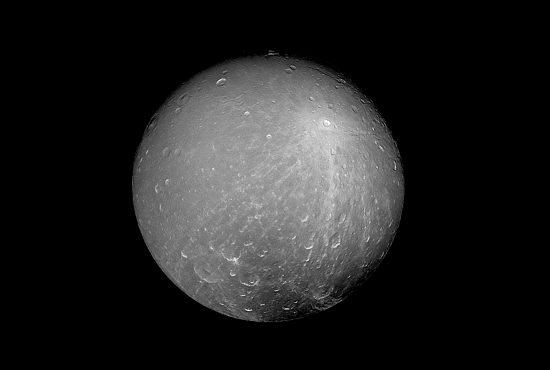
January 14, 2020
Images of Saturn’s moon, Dione reveal trenches and cliffs.
The Cassini-Huygens mission was launched from Cape Canaveral on October 15, 1997. Few now remember the public outcry against the mission. There were several attempts by citizens groups and the ACLU to stop the launch, because 33 kilograms of plutonium-238 provided electrical power to the orbiter. Since there were failures of other launch vehicles, the concern was that an explosion of the Titan IV-B rocket would scatter radiation over many hundreds of square kilometers in southern Florida. However, the launch was uneventful, and Cassini entered orbit around Saturn on July 1, 2004.
A recent press release from Planetary Science Institute Associate Research Scientist Alex Patthoff announced that, “…mysterious straight bright stripes have been discovered on Saturn’s moon Dione.” The “virgae” (streaks of color) are thought to come from material that was “draped” over the moon by a passing comet, or dust from Saturn’s rings. “Their orientation, parallel to the equator, and linearity are unlike anything else we’ve seen in the Solar System.”
When Cassini explored the environment around Saturn, close up images revealed that its moons experienced what might be called, “catastrophic” events in the past. As written in a previous Picture of the Day, Dione is an active world, ejecting streams of charged particles into Saturn’s plasmasphere.
Several bright cliff faces exist on Dione, wrapping around the moon for hundreds of kilometers. In a flyby animation, features that are braided are visible, cutting through craters and intersecting other cliffs. Since Dione has no atmosphere and is only 1126 kilometers in diameter, it was thought to be geologically inactive. Then, plumes of charged particles were discovered erupting from a number of hot spots on its surface.
In the Electric Universe hypothesis, those plumes are plasma discharges ejecting material into space, just as on Jupiter’s moon, Io. It is likely that conditions existed in the past where that activity was much more energetic, forming the etched terrain that is visible today.
The grooves and canyons run parallel to each other. They have sharp rims and begin abruptly with no eroded appearance. They have side canyons running off at ninety-degree angles and craters along their lengths, often in chains. The craters are shallow with no debris around them and have central peaks similar to craters found on Earth’s Moon. In past Picture of the Day articles, such formations have been identified with electric discharge machining.
Saturn’s moons orbit within its plasmasphere and exchange electrical energy with one another, so electricity must be considered whenever unusual morphology is observed. Translating earthly geologic forces and the slow progress of erosion onto the appearance of other planets and moons misses the point. Wind and rain erode our planet and presumably create canyons and valleys. When no wind or rain exists–such as on Dione–how to explain the fresh looking and unique topography that defies convention? Should the assumption that wind and rain, alone, have sculpted the Earth also be questioned?
Stephen Smith
The Thunderbolts Picture of the Day is generously supported by the Mainwaring Archive Foundation.












